
Again Authorized for CPO’s
Presented
is an Ames Civil War M1860 cutlass, dated 1862, without the maker’s imprint on the reverse ricasso or an
Ames serial number, but the hilt shows extensive use. Except for the missing maker’s imprint and the lack of inspector’s
stamps, and serial number, this is an excellent example
of this most desirable collector’s sea service edged weapon having its original scabbard and throg. Confederate
War M1860 cutlasses are very hard to find with an original scabbard. Most of them are either missing their scabbard or
are being sold with one that is a replica. The condition of the scabbard is excellent. It has the expected marks of age, but
there are no breaks or deep cracks. Thirty nine, all original copper rivets, run down
the back and the last one at the tip is larger in size.
The knuckle bow on the brass basket has a flange with an elliptical brass cup which acts as a hand
guard. The curved guard is riveted to the flange and forms a solid half basket. The guard, grip, and mostly
complete leather covering, are in very good condition as is the blade where there only are some minor
small black areas. As was the custom with most grips used at sea, the wire wrap has been removed. The wire
had a tendency to break and make fish hooks which cut the skin so the sailors removed it. Other than the 1862
date,there is
only what may be the rack number 26 stamped at the upper inside quillion.This rare Navy relic is a great dress uniform
addition for current CPO’s, as a gift, or for a collection focused on unique collectibles.
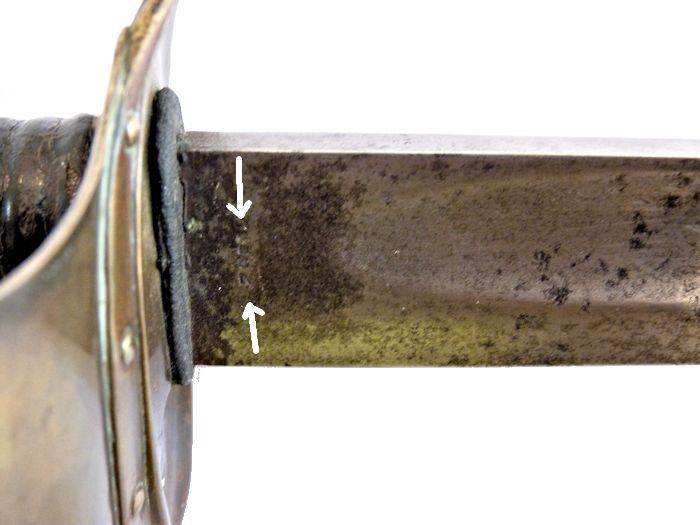 |
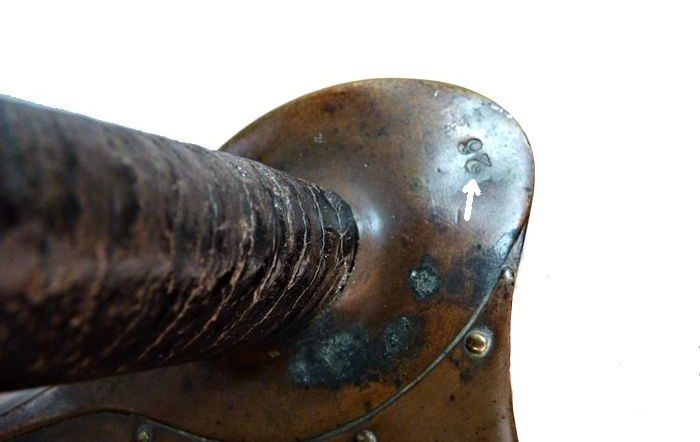 |
1862
date on ricasso above the rack number on inside quillion of guard
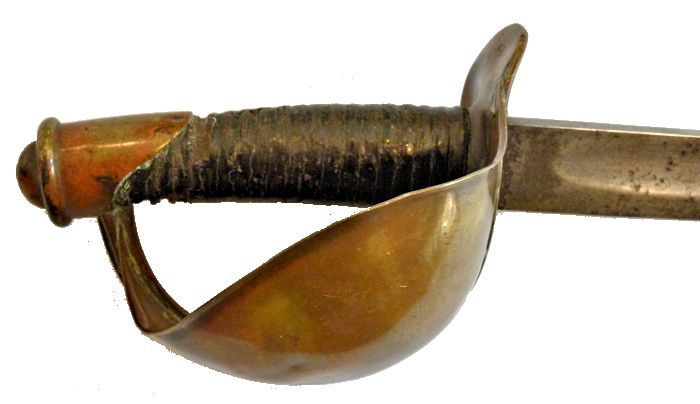 |
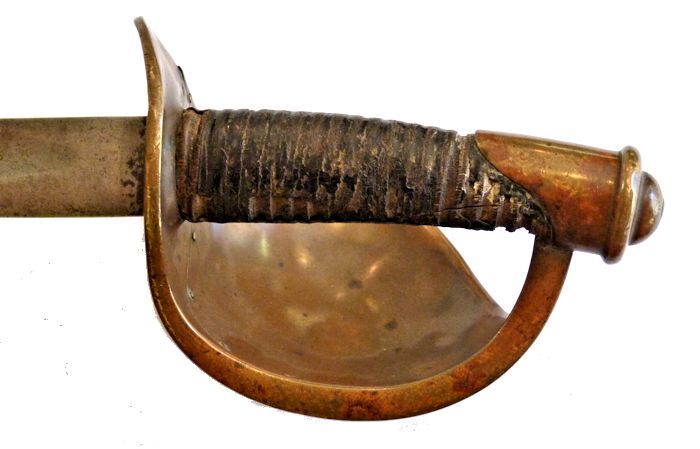 |
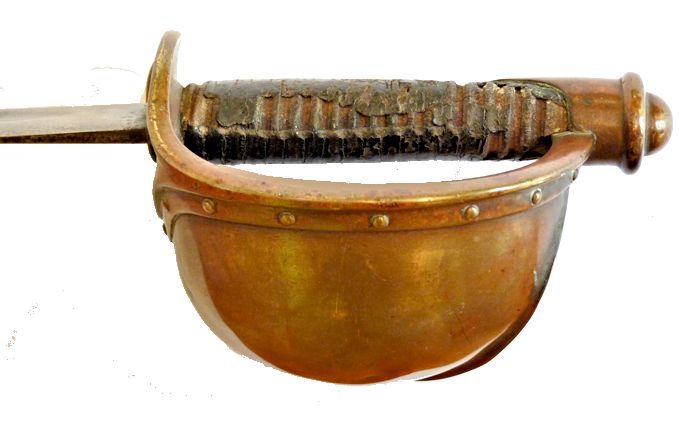 |
Three
views of the basket guard showing missing wire wrap and leather loss
MARKINGS: The
rack number, 26 on the inside top quillion. On the reverse there is the 1862 date on the ricasso. There are no other markings.
CONDITION: The
entire hilt assembly, guard and grip are in excellent condition with only superficial marks of age over the
past 150 years. The grip is unwrapped with copper wire. and is missing about 20% of its leather covering along the
bottom and rear. The original varnish is mostly present. A warm patina of age has turned the brass
golden brown. The hilt and blade are tight. The leather washer is present.
The scabbard is complete and has the original throg which is a rarity. Both are impossible
to find if missing. The unsharpened blade is in very good condition with only some scattered blackening and
pitting on both sides. The rest of the blade is bright.
 Original throg
Original throg
and scabbard with no shrinkage and large rivet at end
DIMENSIONS Cutlass 32″ long overall. 26″ blade length Max width of blade 1 3/16″ Max thickness 5/16″
Fuller 3/4″ W x 19 1/4″ L Weight 2 lbs 12 oz
These measurements and weight exactly match those of known
Ames cutlasses we have sold.
This is a complete example of an Ames
Civil War Cutlass. It would be hard
to find a comparable example!
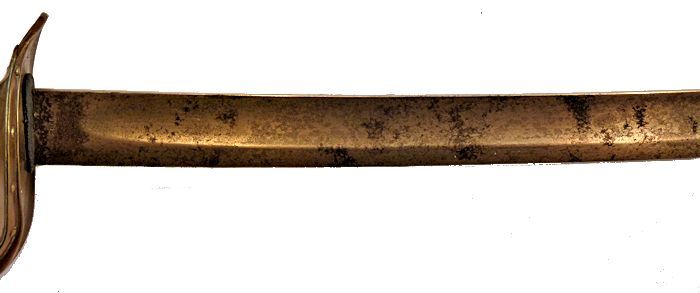 |
 |
 The obverse blade is in very good condition with only random
The obverse blade is in very good condition with only random
spotting. The reverse is similar.
AUTHORIZED
FOR CURRENT NAVY CHIEFS: From the Chief of Naval Personnel Public Affairs WASHINGTON (NNS) — The chief of naval
operations approved a number of uniform changes as announced in NAVADMIN 118/10 March 31. Included in the announcement is
the approval of a Chief Petty Officer (CPO) Ceremonial Cutlass for optional wear by E-7 through E-9s. Chief petty officers
are authorized to wear the cutlass in full dress uniforms when acting as a member of an official party during a ceremony.
However to ensure uniformity, all members of the official party must wear either the cutlass or the sword. Because this is
an optional uniform article, Sailors are responsible for the cost of the item.
BRIEF
HISTORY
Ames Mfg. Co.: The Ames Manufacturing Company, Chicopee, Massachusetts, was founded in 1832 by James Tyler Ames and
his brother, Nathan Peabody Ames. The company manufactured small tools, cotton machinery, swords, cannons, and did casting
of bells. They started production of military contract swords in 1832 with the M1832 foot artillery sword, and ended
with the M1906 cavalry saber in 1906. Ames produced more swords for the American military than any other company before or
since, totaling over 200,000 swords in service by the end of the Civil War. In that time, at least ten different manufacturing
marks were used on the swords. A little knowledge of the company history helps place a date range for when each stamp was
used. When the company started producing swords it was led by Nathan P. Ames, and most marks reflected that fact. In 1847,
Nathan died and left the company to his brother James. The markings on the blades were immediately changed from N.P. Ames
to Ames Mfg. Co. In 1848, the town of Cabotville was incorporated into Chicopee, Massachusetts, and the marks were once again
changed to reflect this. Blades dated as late as 1850 may still bear the Cabotville stamp, as the old dies were
probably used until they were worn out. In a much reduced state, they are still in business today.The Model 1860 cutlass which replaced the Model 1841 saw service during the Civil War, and through the Spanish American War. They likely were used during the
early days of World War I. Based on company records, 22,000 of them were made for the Navy and 300 for the Army by
Ames in two Massachusetts plants. The design for this cutlass was copied from the French naval cutlass used from before
1800 when boarding of enemy vessels was common place. The French affectionately called it “Cuillere-a-pot”
(the soup ladle) and the comparison is obvious.Mostly, from an essay by Mike McWatters
